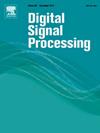用于异质变化检测的图总变化和低秩正则化
IF 3
3区 工程技术
Q2 ENGINEERING, ELECTRICAL & ELECTRONIC
引用次数: 0
摘要
异质变化检测(HCD)具有挑战性,因为各种传感器的成像机制不同,导致图像难以直接比较。为解决这一问题,我们提出了一种基于图的回归算法,利用图总变异正则化和低阶矩阵分解(GTVLR)来进行 HCD 检测。利用图信号处理(GSP)理论,采用有向图(数字图)模型来有效表示图像的方向和相关信息,从而使图过滤后的同域异构数据能够直接比较。GTVLR 框架便于将事件发生后的图像分解为回归图像和变化图像。这种分解可确保回归图像反映出事件发生前图像的结构相似性,而变化图像则突出了变化区域,有助于变化检测。该模型通过 GTV 正则化和 Low-Rank 惩罚分别表征了数据的片状平滑性和 Low-Rank 特性。此外,还通过整合数字图中的高阶相邻信息来完善模型。在三个真实世界数据集上进行的实验以及与几种最先进方法的比较证明了所提算法的有效性。本文章由计算机程序翻译,如有差异,请以英文原文为准。
Graph total variation and low-rank regularization for heterogeneous change detection
Heterogeneous change detection (HCD) is challenging because different imaging mechanisms for various sensors make images difficult to compare directly. To address this problem, a graph-based regression algorithm is proposed for HCD, by leveraging the Graph Total Variation regularization and Low-Rank matrices decomposition (GTVLR). Utilizing graph signal processing (GSP) theory, a directed graph (digraph) model is employed to effectively represent the orientation and correlation information of images, thereby enabling direct comparison of heterogeneous data within the same domain after graph filtering. The GTVLR framework facilitates the decomposition of post-event images into regression and changed images. This decomposition ensures that the regression image mirrors the structure similarity of the pre-event image, while the changed image highlights areas of alteration, aiding in change detection. The model characterizes the piecewise smoothness and Low-Rank properties of data through GTV regularization and Low-Rank penalty, respectively. Moreover, by integrating the higher-order neighboring information within the digraph to refine the model. Experiments conducted on three real-world datasets and comparison with several state-of-the-art methods demonstrate the effectiveness of the proposed algorithm.
求助全文
通过发布文献求助,成功后即可免费获取论文全文。
去求助
来源期刊

Digital Signal Processing
工程技术-工程:电子与电气
CiteScore
5.30
自引率
17.20%
发文量
435
审稿时长
66 days
期刊介绍:
Digital Signal Processing: A Review Journal is one of the oldest and most established journals in the field of signal processing yet it aims to be the most innovative. The Journal invites top quality research articles at the frontiers of research in all aspects of signal processing. Our objective is to provide a platform for the publication of ground-breaking research in signal processing with both academic and industrial appeal.
The journal has a special emphasis on statistical signal processing methodology such as Bayesian signal processing, and encourages articles on emerging applications of signal processing such as:
• big data• machine learning• internet of things• information security• systems biology and computational biology,• financial time series analysis,• autonomous vehicles,• quantum computing,• neuromorphic engineering,• human-computer interaction and intelligent user interfaces,• environmental signal processing,• geophysical signal processing including seismic signal processing,• chemioinformatics and bioinformatics,• audio, visual and performance arts,• disaster management and prevention,• renewable energy,
 求助内容:
求助内容: 应助结果提醒方式:
应助结果提醒方式:


